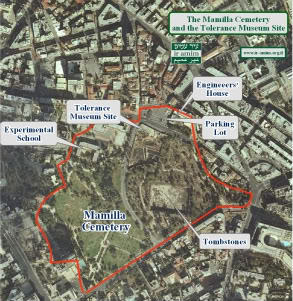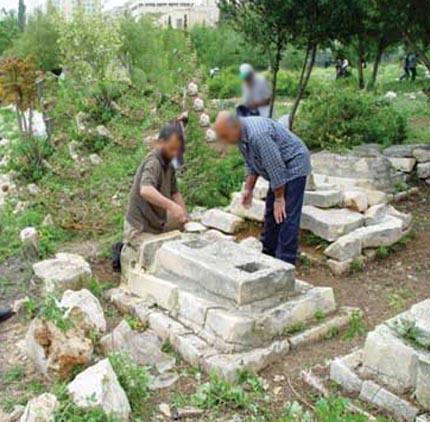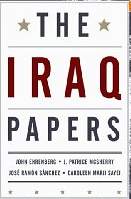Podcast: Play in new window | Download
Updates:
- Admitted CIA Agent Luis Posada Carriles Upcoming Trial in El Paso, TX
- Perjury, Obstruction and Naturalization Fraud on March 1, 2010
- Obama Wraps Himself In The Bush “Anti-Terror” Policies
- Humanitarian Law Project – March 23, 2010 – Material Aid to Terrorism
—-
Simon Wiesanthal Museum of Intolerance: Mamilla Cemetery In Jerusalem
Critics continue to speak out against plans to build the new Simon Wiesanthal Museum of Tolerance near the Mamilla Cemetery. The cemetery is an 800 year old Muslim burial in the heart of Jerusalem and covers about 12 percent of the plot of the new 250 million dollar museum. Today we examine the ongoing legal fights to preserve the cemetery. Mamillacampaign.org
The museum construction has been halted several times in the last few years. Recently, the Israel’s Supreme Court ruled to go ahead with the continued construction, since there was no objection in 1960 when a parking lot was built over a small part of the cemetery. Controversy swirls around the project, the previous architect of the museum project designed an imposing futuristic mix of titanium, glass and stone. Police detain filmmakers
The initial outcry opposing the project came from the Palestinian community, Israeli archaeologists and Ultra-Orthodox Jews. Meanwhile, construction of the museum continues in portions of the area where human remains have not been found. CCR Synopsis
Dima Khalidi:
- Mamilla Cemetery is a huge piece of land located in West Jerusalem It’s an ancient cemetery dating back possibly to the 7th century. Palestinians buried their relatives there since at least 1948
- It has the ancestors of the biggest Jerusalem families including my own family.
- The cemetery has been constantly built on since the fifties and sixties. Our petition to several United Nation bodies is really part of a larger opposition. UN rapporteur on Freedom and Belief and the rapporteur on Ending Racial Discrimination
- We are asking that they label the Mamilla cemetery as a historic site and protect it and move this project, also find the remains that have been dug up so that the Palestinian families can re-bury them. 250 sets of bones removed, at least.
- There are four layers of burials dating back to the 11th century. 2 thousand people buried there.
- The museum’s archeologist called it an archeological crime. The mayor of Jerusalem offered a different site.
- Michael Ratner: what’s going on here is the expulsion of the memory and history of Musliims and Palestinians from Jerusalem
- Israeli Supreme Court handed down a decision in December 2009 affirming previous decision that it was legal to build this museum on top of the cemetery.
Guest – Palestinian-American lawyer Dima Khalidi. Dima is based in Chicago, she has a JD from DePaul University College of Law in Chicago and a Masters from the School of Oriental and African Studies, University of London in International and Comparative Law with a focus on Islamic Law. She has worked with the People’s Law Office in Chicago, and the Center for Constitutional Rights (CCR) in New York. Prior to studying law, she spent two years working in the West Bank at Birzeit University on a project studying the role of customary/tribal law in Palestinian society. She has been working on the Mamilla cemetery case with CCR and other attorneys in recent months.
——-
The Iraq Papers: John Ehrenberg
Political science professor and author John Ehrenberg joined hosts live in the studio to talk about a book he had worked on with 4 other colleagues titled The Iraq Papers. (From the review) The book offers a compelling documentary narrative and interpretation of this momentous conflict. With keen editing and incisive commentary, the book weaves together original documents that range from presidential addresses to redacted memos, carrying us from the ideology behind the invasion to negotiations for withdrawal. These papers trace the rise of the neoconservatives and reveal the role of strategic thinking about oil supplies.
The authors also provide Congressional resolutions and speeches by President Bush, but internal security papers, Pentagon planning documents, the report of the Future of Iraq Project, and eloquent opposition statements by Senator Robert Byrd, other world governments, the Non-Aligned Movement, and the World Council of Churches.
John Ehrenberg:
- The book is a compendium of presidential speeches, position papers, news conferences.
- All the way from those who planned it beginning in the late 1990s to those who fought it in Iraq,
- This is not a neutral book, this is a reader with an attitude. It’s an anti-war reader. We try to be fair, and try to represent the many voices in the Iraq war. The lead up to the war so marked by misinformation, duplicity, lies, silence, everybody’s hands are dirty on this.
- As we debated, we really came to the one single variable that could be used to describe this war.
- with the fall of the Soviet Union is the late 80s, there arose in Washington a group of insiders who thought with considerable evidence that the world had passed from a bipolar system to a unipolar system, these groups became consolidated into groups one of which became PNAC (Project for the New American Century)
- Their view was that history had presented the US with a unique moment to cement its hegemony over the entire world. It’s really as simple and scary as that.
- Why care about it now? A lot of reasons. To what extent did unilateralism and pre-emption simply mirror the longstanding trends in American foreign policy? We split the middle and decided both were true.
- The people who signed PNAC go into the state department of the Bush Administration.
- The neo-conservatives haven’t disappeared. Every couple weeks, Dick Cheney gets on the air to attack Obama. Sara Palin.
- The architecture of the Iraq war, the reasons for it are still alive and kicking. There’s a very good piece in the NY Times that Gary Wills wrote. He says it doesn’t matter how reformist he/she is that comes into power, confronts the “deep state”
- They are deep beneath the surface and are immune to democratic power and they are not touched by elections or anything else. Coming into power (Obama) is confronted en mass by secret treaties, foreign obligations, military entanglements, hundreds of bases, hundreds of countries.
- Assuming he was honest, he would be unable to disentangle from that apparatus. I think Afghanistan is a way to protect Obama from the right on charges of abandoning Iraq. I don’t think Obama’s people are under any illusions to think that they can do what others couldn’t in recorded history.
- This is a holding operation to provide them with cover. We have a document called the Kubark, its a CIA manual (read manual) that became declassified a few years ago, that basically outlines all of the torture techniques.
- The basic orientation of the Bush foreign policy was organized around what we call pre-emption.
- These guys were clear in their intention, and the astounding thing is they announced their intention years before.
- None of this should have come as a shock to people. The claim was power trumps everything.
- You can’t solve political issues militarily, and that’s what the neo-cons were convinced they could do.
Guest – John Ehrenberg, author of Servants of Wealth, The Rights Assault on Economic Justice, and recently, The Iraq Papers. He’s also professor of political science at Long Island University.


